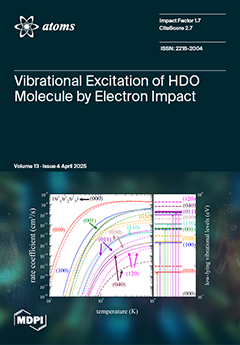Open AccessEditor’s ChoiceArticle
The Laboratory Measurement of the Line Ratios in X-Ray Emission Resulting from the Charge Exchange Between Mg11+ and Helium
by
Kebao Shu, Caojie Shao, Shuo Zhang, Ruitian Zhang, Cheng Qian, Yingli Xue, Mingwu Zhang, Jinlei Tian, Zhenqiang Wang, Xiaolong Zhu, Liangting Sun, Junxia Ran and Deyang Yu
Viewed by 814
Abstract
The line ratios in X-ray emission resulting from charge exchange between highly charged ions (HCIs) and neutral atoms are not only crucial for accurately modeling astrophysical X-ray emissions but also offer a unique perspective on the charge exchange processes happening during collisions. The
[...] Read more.
The line ratios in X-ray emission resulting from charge exchange between highly charged ions (HCIs) and neutral atoms are not only crucial for accurately modeling astrophysical X-ray emissions but also offer a unique perspective on the charge exchange processes happening during collisions. The
K X-ray spectra following charge exchange between Mg
11+ and He are presented for a collision velocity of 1489 km/s (11.5 keV/amu). The spectra were measured by two Silicon Drift Detectors capable of resolving the Mg
10+ Kα,
Kβ,
Kγ, and
Kδ+ lines. The line intensity ratios of
Kβ,
Kγ, and
Kδ+ relative to the
Kα line, as well as the hardness ratio, were obtained. The experimental results were compared with the theoretical results from a cascade model that utilizes the state cross-sections produced by multichannel Landau–Zener (MCLZ) calculation. It was discovered that the
K X-ray spectrum features can be reproduced well by MCLZ theory when the contributions of both single electron capture (SEC) and autoionizing double capture (ADC) processes are included. This finding implies that the ADC feeding mechanism is significant and should be taken into account for the X-ray emission during charge exchange between highly charged ions and multielectron atoms.
Full article
►▼
Show Figures





